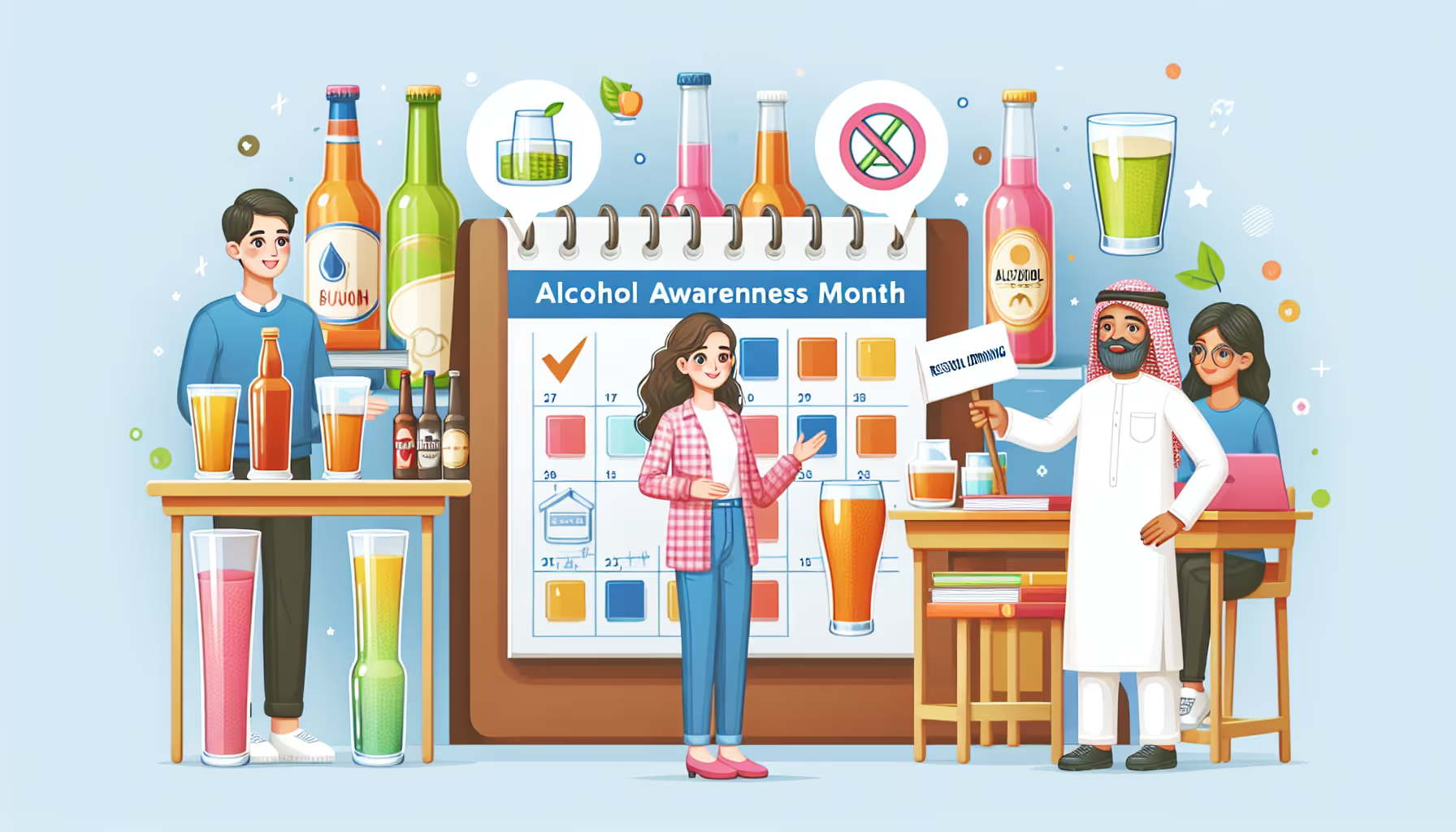Delving into the Meaning of Alcohol Awareness Month

Understanding Alcohol Awareness Month
In a bid to provide clarity on the subject of Alcohol Awareness Month, this section explores its significance and briefly outlines its history.

Significance of Alcohol Awareness Month
April is recognized as Alcohol Awareness Month in the United States. The primary aim of this observance is to educate the public about alcohol use disorder (AUD) and the detrimental impacts of alcohol misuse on both health and society. This period is dedicated to increasing public insight into alcohol-related issues and emphasizing the importance of prevention, effective treatment, and recovery.
Alcohol misuse is associated with over 200 disease and injury-related conditions and results in more than 178,000 deaths annually in the US, making it a leading preventable cause of death.
The observance of Alcohol Awareness Month also underscores the need for support services for individuals grappling with alcohol use and misuse, aiding in their recovery journey.
History of Alcohol Awareness Month
The National Council on Alcoholism and Drug Dependence initiated Alcohol Awareness Month in April 1987. The primary objective was to target college-aged students to increase awareness about the perils of alcoholism and related issues. Over the years, this observance has grown to encompass a broader audience, aiming to educate the general public about the realities of alcohol misuse and its potential consequences.
Understanding the history and significance of Alcohol Awareness Month is crucial in comprehending the magnitude of alcohol-related issues in the United States. The observance plays a vital role in creating awareness, promoting treatment, and emphasizing the importance of recovery and support services.
Alcohol Misuse Statistics
In order to fully grasp the importance of Alcohol Awareness Month, it's crucial to understand the prevalence of alcohol use and the impact of alcohol misuse.
Prevalence of Alcohol Use
In the United States, alcohol use is widespread. According to the American Addiction Centers, more than 133 million people aged 12 and older consumed alcohol in 2021. Moreover, the National Institute on Alcohol Abuse and Alcoholism (NIAAA) reports that over 14 million adults aged 18 and older in the United States have alcohol use disorder (AUD), which includes both alcohol dependence and abuse. Furthermore, 1 in 10 children live in a home with a parent who has a drinking problem.
In addition, an estimated 26.45% of Americans aged 18 and older engaged in binge drinking and 6.6% in heavy alcohol use in 2018.
Impact of Alcohol Misuse
The misuse of alcohol has far-reaching consequences, both for individuals and for society. It's estimated that more than 178,000 deaths occur annually in the United States due to alcohol, making it a leading preventable cause of death. Moreover, over 200 disease and injury-related conditions are linked to alcohol misuse.
In terms of fatal accidents, alcohol-impaired driving fatalities accounted for 31% of overall driving fatalities (9,967 deaths) in 2014 [4].
Moreover, the economic burden of excessive alcohol use is significant. Problematic alcohol use cost the U.S. an estimated $249 billion in 2010, with binge drinking contributing to three-quarters of this economic burden [4].
These statistics underscore the importance of Alcohol Awareness Month and the critical need for education, prevention, and treatment efforts. The impact of alcohol misuse is not only a health concern but also a societal and economic issue. By raising awareness and providing resources for help, we can work to mitigate the harmful effects of alcohol misuse.
Health Implications of Alcohol Misuse
Understanding the implications of alcohol misuse is crucial for creating awareness and mitigating its impact. These implications are not only restricted to physical health but also extend to mental health.
Physical Health Effects
Excessive alcohol consumption can lead to various health problems. Some of these include liver disease, cardiovascular disease, cancer, and neurological disorders. Alcohol misuse is also associated with several gastrointestinal symptoms and risk factors related to the development of ulcers.
Furthermore, alcohol is the most prevalent substance involved in substance-related emergency department visits, as highlighted in the Drug Abuse Warning Network (DAWN) report released by SAMHSA. This underscores the immediate and severe physical health risks associated with alcohol misuse [3].
Information courtesy of Recovery Centers of America.
Mental Health Effects
In addition to the physical health effects, alcohol misuse can also significantly affect an individual's mental health. It increases the risk of depression, anxiety, and suicidal thoughts [6].
Alcoholism, also referred to as alcohol addiction, is a chronic medical condition that can counteract its effects on the brain and behavior. With appropriate treatment, individuals can regain control of their lives.
The physical and mental health implications of alcohol misuse highlight the importance of Alcohol Awareness Month. It serves as a reminder of the potential harm of excessive alcohol consumption and the necessity for treatment and prevention efforts.
Treatment and Support
Addressing alcohol misuse requires both treatment and support. While the journey to recovery can be challenging, it's important to note that alcoholism, labeled as alcohol addiction, is considered a treatable chronic medical condition by the American Society of Addiction Medicine. Treatment can counteract its effects on the brain and behavior, allowing individuals to regain control of their lives.
Approaches to Alcohol Use Disorder
Treatment for alcohol problems can involve a variety of approaches. These may include behavioral treatments led by health professionals, medications, and mutual-support groups like Alcoholics Anonymous (AA).
The choice of treatment should be tailored to the individual's needs and preferences.
Resources for Recovery
Several resources are available to assist individuals on their recovery journey. The National Institute on Alcohol Abuse and Alcoholism (NIAAA) recently launched the NIAAA Alcohol Treatment Navigator, an online tool that helps individuals find the right treatment for alcohol problems and guides them through a step-by-step process to find a highly qualified professional treatment provider.
Treatment options for alcohol use disorder vary based on individual needs, with the FDA approving medications to treat alcohol use disorder at different stages of recovery, making recovery possible for those struggling with alcohol use or misuse.
Additionally, SAMHSA offers resources to help parents, caregivers, and other adults talk to young people about the risks of using alcohol and other substances of misuse as part of the efforts to promote alcohol misuse prevention and awareness.
Through a combination of treatment, support, and resources, individuals can navigate the path to recovery. This underscores the importance of Alcohol Awareness Month, a time to highlight the need for public awareness, understanding, and action on this critical issue.
Prevention Strategies
Understanding the significance of Alcohol Awareness Month involves exploring the prevention strategies in place to combat alcohol misuse. These strategies aim to decrease the prevalence of alcohol use, especially among underage individuals, and prevent the physical and mental health effects associated with alcohol misuse.
Underage Drinking Prevention
Over the past 20 years, prevention efforts have successfully reduced alcohol misuse among youth and young adults in the United States. Current drinking among 12- to 17-year-olds decreased from 34.6 percent in 2002 to 18.5 percent in 2020, and among 18- to 25-year-olds, it declined from 77.9 percent to 69.5 percent during the same period.
Parents, caregivers, and other adults interacting with young people play a crucial role in educating them about the risks and harms associated with alcohol and other substance misuse. Providing tools and resources to engage young people in conversations about the importance of alcohol avoidance and healthy lifestyle choices is essential.
Multifaceted Prevention Approaches
Prevention strategies against underage drinking are most effective when implemented through a multifaceted approach. This approach involves parents, families, law enforcement, health care providers, community organizations, schools, universities, local and state governments, and the federal government [7].
This comprehensive approach ensures that the message of prevention and the dangers of alcohol misuse reach the targeted audience from various angles. This amplifies the impact of the prevention efforts and makes it more likely that the message will resonate with those at risk.
As part of these efforts, the Substance Abuse and Mental Health Services Administration (SAMHSA) offers resources to help parents, caregivers, and other adults talk to young people about the risks of using alcohol and other substances of misuse. These resources can be a valuable tool in promoting alcohol misuse prevention and awareness during Alcohol Awareness Month and beyond [7].
As we answer the question 'what is Alcohol Awareness Month?', we understand that it's not just about spreading awareness but also about taking action. With these prevention strategies and resources, everyone can contribute to reducing alcohol misuse and its associated harms.
References
[1]: https://www.niaaa.nih.gov/news-events/announcement/april-alcohol-awareness-month
[2]: https://www.niaaa.nih.gov/publications/brochures-and-fact-sheets/treatment-alcohol-problems-finding-and-getting-help
[3]: https://www.samhsa.gov/newsroom/observances/alcohol-awareness-month
[4]: https://alcohol.org/awareness-month/
[5]: https://americanaddictioncenters.org/alcohol/risks-effects-dangers/alcohol-misconceptions
[6]: https://recoverycentersofamerica.com/blogs/understanding-the-importance-of-alcohol-awareness-month/
[7]: https://www.samhsa.gov/blog/promoting-alcohol-misuse-prevention-april
You’re not alone in this.
When mental health challenges and addiction intersect, it can feel isolating. At Arista, we offer compassionate, evidence-based, and trauma-informed care to help you heal, grow, and move forward.
You’re not alone in this.
When mental health challenges and addiction intersect, it can feel isolating. At Arista, we offer compassionate, evidence-based, and trauma-informed care to help you heal, grow, and move forward.
Support that moves with you.
You’ve taken a brave first step. At Arista Recovery, we’re here to help you continue with best-in-class care designed for long-term healing and support.
.webp)






